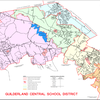Water endangered quot Pair press concerns on reservoir expansion
GUILDERLAND Two environmental leaders in Guilderland are frustrated their concerns about a project to expand the Watervliet Reservoir are being, they say, ignored.
"It’s got to be a crisis situation before people get upset," said Charles Rielly. Rielly co-chairs, with Thadeus Ausfeld, the Restoration Advisory Board, which advises the Army Corps of Engineers on the cleanup of the old Army depot in Guilderland Center. Ausfeld runs the Guilderland water-treatment plant for the town.
Both have opposed the reservoir expansion since the plan was made public this spring.
"I just think they need to look at it more in depth," Ausfeld said. "You need to look at this for 200 years from now."
Meanwhile, Jim Besha, president of Albany Engineering, the firm in charge of the project, said that any problems with the reservoir will be addressed in the lengthy review process.
"This is moving forward in a comprehensive fashion," Besha said, "so any question should be answered."
Besha said the projects planners can only work with data, not speculation or theories.
"If someone’s got real data, I’d like to see it," Besha said.
Rielly states in a letter to the Enterprise editor that he has repeatedly asked Watervliet for data on sedimentation, for example, which he believes is filling in the reservoir, and his requests have been ignored.
Though located on the Normanskill in Guilderland, the Watervliet Reservoir is owned by the city of Watervliet. It provides drinking water to all of Watervliet and those in Guilderland with public water.
Watervliets plan is to modify the dam on the Normanskill with a computerized system that will stabilize the surface of the reservoir at 267 feet above sea level. Currently, the reservoir fluctuates with the season, reaching 267 feet only in the spring. The higher dam would increase the reservoirs capacity by half, flooding 50 acres in a thin strip along the reservoirs edge to bring the surface area to about 980 acres. Watervliet hopes to sell some of the extra water to other municipalities.
Watervliet is currently in the midst of preparing its application for approval from the Federal Energy Regulatory Commission, Besha said, which is required because the reservoir generates a small amount of hydro-power. The commission requires a number of studies to be done, including ones on water quality and sedimentation, and slope stability.
Also, Watervliet will soon lead a full environmental impact assessment under the State Environmental Quality Review Act (SEQRA).
"Swamp water"
Rielly and Ausfelds main concern is that the reservoir is already in bad condition and expansion will only take a smaller problem and make it bigger, they said.
"The water quality is very unstable. It’s just not a very good water supply," Ausfeld said.
Even with Guilderlands top-of-the-line equipment, water system operators have a difficult time making the water drawn out of the reservoir drinkable, Ausfeld said. The process is much more difficult than in other towns where hes talked to water managers.
One of the main problems is siltation, Rielly and Ausfeld said. Mud from the large watershed is making its way into the reservoir, coating the bottom with a thick layer of muck, they said.
As a boy, Rielly said, he was able to fish at the north end of the reservoir. Not so anymore; huge mud flats prevent it, Rielly said.
The bottom of the reservoir is "like quicksand," Ausfeld said. One of the town’s intake pipes is completely clogged up, and the others are on their way, he said.
"Swamp water doesn’t make very drinkable water," he said.
Ausfeld cited a 1978 Watervliet study done by Besha. In it, Besha writes that increased growth in the watershed will cause increased run-off and, therefore, more siltation.
"Sedimentation...as a by-product of the increased runoff rates will be noticeable due to the generally silty nature of the soils and unstable bank condition of the major streams," Besha writes in the quarter-century-old report.
This week, Besha said there has been an increased amount of sediment in the reservoir over the years, but that is to be expected and part of the natural life of any watershed.
Later in the report, Besha writes about eutrophication, vegetative growth, in the reservoir. In addition to decreasing the waters oxygen content, vegetation traps more silt, Besha writes.
"Increased vegetation in the upper reaches of the reservoir...will substantially reduce the velocity in that region and increase the trap efficiency throughout the year, increasing sedimentation," the report says.
On a press tour of the reservoir in the spring, Besha led reporters on a boat across a wide floating field of European chestnuts. Though too much chestnut growth is bad for the water quality, Besha said at the time, the plants suck up a lot of the nutrients, keeping worse invaders, like millfoil, out. So, he said, Watervliet controls, but doesnt eliminate, the chestnuts.
Although they admit Watervliet is trying to control the chestnuts, the citys not doing enough, Ausfeld and Rielly said.
"We’ve had problems with organic overloads," Ausfeld said. "That doesn’t make good drinking."
Also in the 1978 report, Besha writes, "Wide fluctuations in the reservoir surface elevation will affect both the amount of sediment in the reservoir and the distribution of the sedimentation in the reservoir."
Rielly and Ausfeld dont believe the proposed computerized system really will hold the depth stable, and a larger reservoir just means more sedimentation and bank erosion. At an informational meeting this spring, a few local landowners complained about erosion.
"If they start selling water during the dry spell, the reservoir’s going to go down," Rielly said.
Besides, Rielly and Ausfeld said, the dam cant always be operating properly.
"I don’t understand what’s going to keep that thing from getting jammed up," Ausfeld said. It’s not uncommon for logs and other large objects to come floating down the creek, he said.
Besha said the reservoir may indeed go down a bit when the weather is dry and theres more demand for water, but, again, thats natural for any reservoir. However, Besha said, the computerized system will keep the annual variation in water level much smaller than it is now.
As for the dam malfunctioning, Besha said, its up to all current standards and subject to regular inspection.
Watershed planning
Rielly and Ausfeld support a comprehensive look at the whole watershed.
"They should be talking with Duanseburg, Princetown, Rotterdam, and holding regular meetings," Rielly said.
The Watervliet watershed is huge compared to the size of the reservoir. It covers nine towns, three counties, and 120 square miles. Besha has attributed the reservoirs relative stability to the large watershed, but Rielly and Ausfeld say it causes problems as well, especially with increased development in recent years.
"They say it’s the size of the watershed, but it’s what’s going on in the watershed that matters," Ausfeld said.
The current set of watershed rules and regulations was written in a different era, the duo pointed out. It has outdated regulations dealing with things like labor camps and outhouses too close a stream or the reservoir.
A new set of regulations was drafted a few years ago, with input from the affected towns, but no town or governmental agency has approved it, and discussion of it has ceased, Rielly and Ausfeld said.
Rielly and Ausfeld said they havent gotten much response to their complaints, including from elected officials in Guilderland. But if nothing is done, they said, the reservoir will soon be in dire straits.
"The cost of purifying that water is going to get so expensive, it’ll be ridiculous," Ausfeld said. "One-hundred years from now, no one will use it for drinking water."


